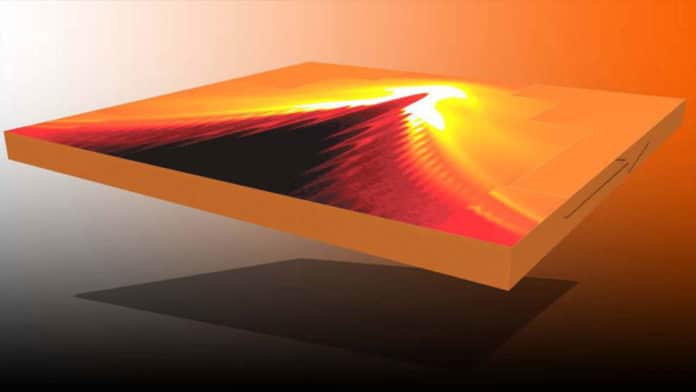Scientists at Princeton University have detected superconducting currents along the exterior edge of a superconducting material. This discovery indicates a pathway for topological superconductivity that could be an aid in future quantum computers.
This is for the first time that an edge supercurrent has been observed in any superconductor.
Nai Phuan Ong, Princeton’s Eugene Higgins Professor of Physics and the senior author of the study, said, “Our motivating question was, what happens when the interior of the material is not an insulator but a superconductor? What novel features arise when superconductivity occurs in a topological material?”
To investigate superconductivity in topological materials, the analysts went to a crystalline material called molybdenum ditelluride, which has topological properties and is additionally a superconductor once the temperature dips underneath a frigid 100 milliKelvin, which is – 459 degrees Fahrenheit.
Stephan Kim, a graduate student in electrical engineering, who conducted many of the experiments, said, “Most of the experiments done so far have involved trying to ‘inject’ superconductivity into topological materials by putting the one material close to the other. What is different about our measurement is we did not inject superconductivity, and yet we were able to show the signatures of edge states.”
Scientists initially grew crystals in the lab and then cooled them down to a temperature where superconductivity occurs. By applying a weak magnetic field to the crystal, the critical current displays oscillations, which appear as a saw-tooth pattern, as the magnetic field is increased.
Both the height of the oscillations and the recurrence of the motions fit with forecasts of how these fluctuations emerge from the quantum behavior of electrons kept to the edges of the materials.
Wudi Wang, who as the first author led the study and earned his Ph.D. in physics from Princeton in 2019 said, “When we finished the data analysis for the first sample, I looked at my computer screen and could not believe my eyes, the oscillations we observed were just so beautiful and yet so mysterious. It’s like a puzzle that started to reveal itself and is waiting to be solved. Later, as we collected more data from different samples, I was surprised at how perfectly the data fit together.”
Ong said, “The script the electrons are following is called the superconductor’s wave function, which may be regarded roughly as a ribbon stretched along the length of the superconducting wire. A slight twist of the wave function compels all Cooper pairs in a long wire to move with the same velocity as a “superfluid” — in other words acting as a single collection rather than like individual particles — that flow without producing heating.”
“If there are no twists along with the ribbon, the Cooper pairs are stationary, and no current flows. If the researchers expose the superconductor to a weak magnetic field, this adds contribution to the twisting that the researchers call the magnetic flux, which, for very small particles such as electrons, follows the rules of quantum mechanics.”
These two contributors to the number of twists, the superfluid velocity, and the magnetic flux, work together to maintain the number of twists as an exact integer, a whole number such as 2, 3, or 4 rather than a 3.2 or a 3.7. They predicted that as the magnetic flux increases smoothly, the superfluid velocity would increase in a saw-tooth pattern as the superfluid velocity adjusts to cancel the extra .2 or add .3 to get an exact number of twists.
Measurements were taken as the superfluid current varies the magnetic flux.
In molybdenum ditelluride and other so-called Weyl semimetals, this Cooper-pairing of electrons in bulk appears to induce a similar pairing on the edges.
Ong said, “From classical expectations, one would expect two-fluid puddles that are in direct contact to merge into one. Yet the experiment shows that the edge condensates remain distinct from that in the bulk of the crystal.”
Scientists speculate that the mechanism that keeps the two condensates from mixing is the topological protection inherited from the protected edge states in molybdenum ditelluride. The group hopes to apply the same experimental technique to search for edge supercurrents in other unconventional superconductors.
Journal Reference:
- Wudi Wang, Evidence for an edge supercurrent in the Weyl superconductor MoTe2. DOI: 10.1126/science.aaw9270
